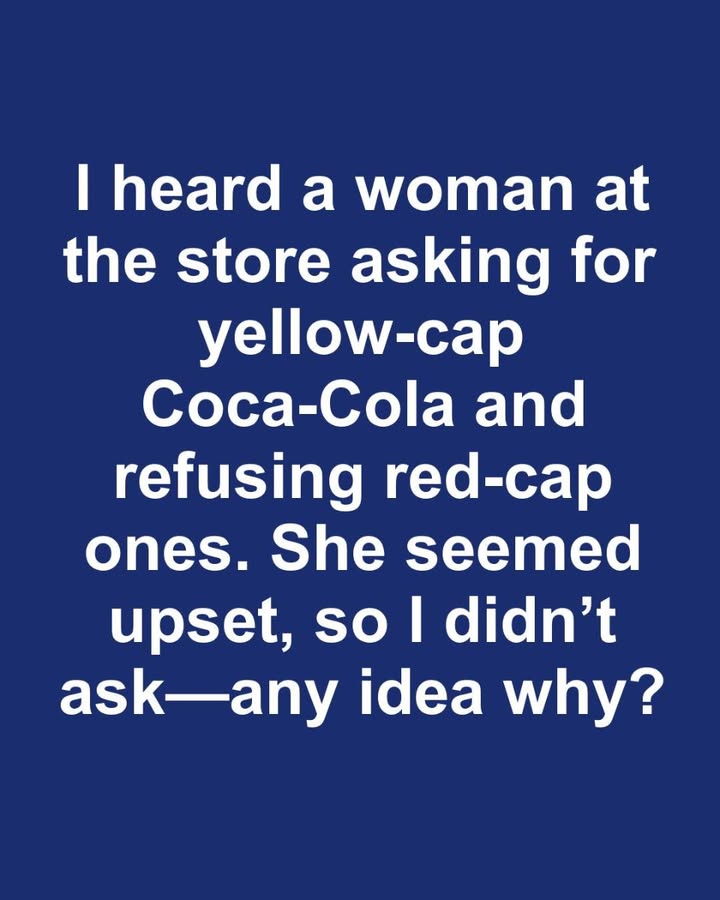While shopping at my neighborhood grocery store recently, I couldn’t help but overhear a woman anxiously asking for Coca-Cola with a yellow cap, while firmly refusing any with a red cap. Her tone was urgent, and her insistence on the yellow-capped version was so strong that it caught my full attention.

I was curious to know what could possibly make one Coca-Cola cap color so much more desirable than another, but I refrained from asking her directly, not wanting to intrude on her personal business. Still, the incident stuck with me, and I started wondering—what’s the real difference between Coca-Cola with a yellow cap versus the regular red-cap version that we all know so well? As I began digging into the matter, I learned that Coca-Cola, one of the most iconic beverage brands in the world, often uses different colored caps to distinguish between variations of their products.
While the classic red cap is synonymous with the standard Coca-Cola formula sweetened with high fructose corn syrup, a yellow cap actually signifies something quite different and meaningful. In fact, yellow-cap Coca-Cola is specially produced for Passover, a major Jewish holiday during which observant individuals avoid certain leavened products and grains, including corn. Because high fructose corn syrup is derived from corn, it is not considered kosher for Passover. In response to this religious requirement, Coca-Cola creates a limited-time version of the drink sweetened with cane sugar instead of corn syrup, and this version is marked by a yellow cap to differentiate it. So, while some people seek out the yellow cap for religious observance, others may do so for different reasons altogether.
Some consumers simply prefer the taste of Coca-Cola made with cane sugar, claiming it has a cleaner, smoother, or more nostalgic flavor compared to its high-fructose counterpart. In fact, many people believe the cane sugar formula tastes closer to the original Coca-Cola recipe before the widespread switch to corn syrup in the U.S. back in the 1980s. For these individuals, it’s not about religion—it’s about taste and perhaps even a bit of nostalgia. In other cases, consumers may choose yellow-cap Coca-Cola because they perceive cane sugar as a healthier or more natural alternative to high fructose corn syrup.
While both sweeteners provide similar calorie content, some people are more comfortable consuming products with ingredients they view as more traditional or less processed. Individuals with sensitivities or dietary restrictions might also find the yellow-cap version to be a better fit for their needs. On a broader scale, Coca-Cola often tailors its products to suit different cultural and regional preferences. In some countries, such as Mexico, Coca-Cola is typically made with cane sugar year-round, and many U.S. consumers go out of their way to purchase “Mexican Coke” for its perceived superior taste. The yellow-cap version sold in the U.S. during Passover follows the same idea—adapting the product to align with cultural expectations, religious practices, and consumer preferences. Moreover, the uniqueness of the yellow cap has also created a sense of rarity and exclusivity. Since it’s only available for a short period during the Passover season, some Coca-Cola fans treat it like a limited-edition release. Collectors and enthusiasts may stock up when they see it in stores, and savvy marketers understand how limited-time offers can increase demand and interest. This combination of religious significance, personal taste preference, and perceived value makes the yellow-cap Coca-Cola something of a phenomenon during the spring. Ultimately, the woman in the grocery store may have had any number of reasons for her firm insistence on finding the yellow-cap bottle. Whether she needed it for religious reasons, preferred the taste of cane sugar, or simply enjoyed the uniqueness of a limited product, her preference reflects a larger story about how even the smallest product details can hold deep meaning. What seemed like just another bottle of soda actually carried layers of cultural, dietary, emotional, and personal significance. It’s fascinating to realize how something as seemingly minor as a cap color can shape a consumer’s choice and reveal so much more than meets the eye.





